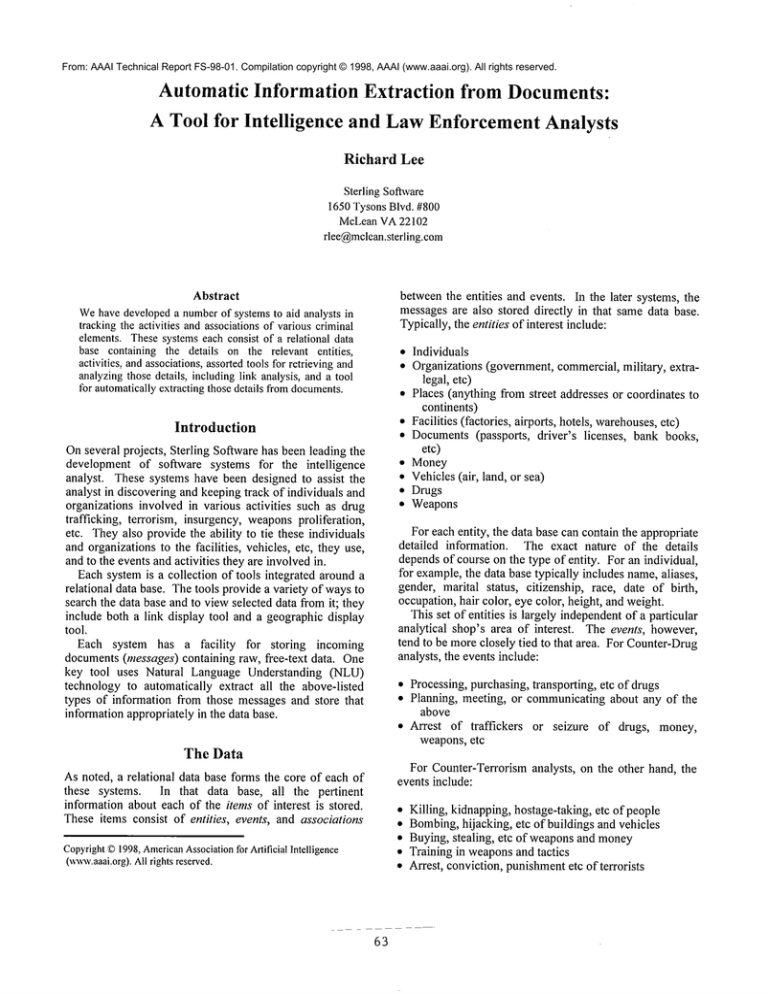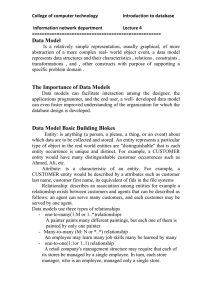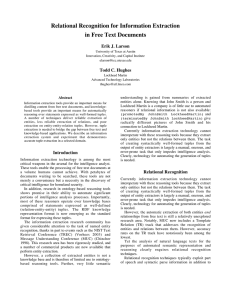
From: AAAI Technical Report FS-98-01. Compilation copyright © 1998, AAAI (www.aaai.org). All rights reserved.
Automatic Information Extraction from Documents:
A Tool for Intelligence
and Law Enforcement Analysts
Richard
Lee
Sterling Software
1650TysonsBlvd. #800
McLeanVA22102
rice@mclean.sterling.corn
betweenthe entities and events. In the later systems, the
messagesare also stored directly in that same data base.
Typically,the entities of interest include:
Abstract
Wehavedevelopeda numberof systemsto aid analysts in
trackingthe activities and associationsof variouscriminal
elements. Thesesystemseach consist of a relational data
base containing the details on the relevant entities,
activities, andassociations,assortedtools for retrievingand
analyzingthose details, includinglink analysis, anda tool
for automaticallyextractingthose details fromdocuments.
¯ Individuals
¯ Organizations (govermnent, commercial, military, extralegal, etc)
¯ Places (anything from street addresses or coordinates to
continents)
¯ Facilities (factories, airports, hotels, warehouses,etc)
¯ Documents(passports, driver’s licenses, bank books,
etc)
¯ Money
¯ Vehicles(air, land, or sea)
¯ Drugs
¯ Weapons
Introduction
Onseveral projects, Sterling Software has been leading the
development of software systems for the intelligence
analyst. These systems have been designed to assist the
analyst in discovering and keeping track of individuals and
organizations involved in various activities such as drug
trafficking, terrorism, insurgency, weaponsproliferation,
etc. Theyalso provide the ability to tie these individuals
and organizations to the facilities, vehicles, etc, they use,
and to the events and activities they are involvedin.
Eachsystem is a collection of tools integrated around a
relational data base. The tools provide a variety of waysto
search the data base and to view selected data from it; they
include both a link display tool and a geographic display
tool.
Each system has a facility
for storing incoming
documents(messages) containing raw, free-text data. One
key tool uses Natural Language Understanding (NLU)
technology to automatically extract all the above-listed
types of information from those messages and store that
information appropriately in the data base.
For each entity, the data base can contain the appropriate
detailed information. The exact nature of the details
dependsof course on the type of entity. For an individual,
for example,the data base typically includes name,aliases,
gender, marital status, citizenship, race, date of birth,
occupation, hair color, eye color, height, and weight.
This set of entities is largely independentof a particular
analytical shop’s area of interest. The events, however,
tend to be moreclosely tied to that area. For Counter-Drug
analysts, the events include:
¯ Processing, purchasing, transporting, etc of drugs
¯ Planning, meeting, or communicatingabout any of the
above
¯ Arrest of traffickers or seizure of drugs, money,
weapons, etc
The Data
For Counter-Terrorism analysts, on the other hand, the
events include:
As noted, a relational data base forms the core of each of
these systems. In that data base, all the pertinent
information about each of the items of interest is stored.
These items consist of entities, events, and associations
¯
¯
¯
¯
¯
Copyright
©1998,American
Association
for Artificial Intelligence
(x~vw.aaai.org).
Allrightsreserved.
63
Killing, kidnapping, hostage-taking, etc of people
Bombing,hijacking, etc of buildings and vehicles
Buying, stealing, etc of weaponsand money
Training in weaponsand tactics
Arrest, conviction, punishmentetc of terrorists
¯ Other government actions knownto provoke terrorist
retaliation
mappedto a single data base record, with each slot mapped
to a data base field, but it is often morecomplicated. Each
item in an association record is of course stored in the data
base using the key for the correspondingitem record.
The associations can be groupedinto three categories:
¯ Entity-to-entity
¯ Entity-to-event
¯ Event-to-event
Technical
Approach
The IE’s analysis of text is accomplishedby applying large
collections of patterns. The patterns for recognizing entity
references use a combination of internal structures and
external contextual clues, each involving both syntactic
and semantic information about words and phrases. For
example, the phrase "Analyst John Q. Jacobson of
Marigold Financial Corp" contains both internal and
external indicators for both the individual and the
organization. Each reference thus recognized is reducedreplaced by a single token - with the pieces of recognized
information (name, title, occupation, etc) distributed
appropriately into slots in the attached frame.
After the entity analysis is done, the relation analysis
uses patterns which look for text containing the right
combinations of relation-specifying words and phrases,
entity tokens, and other bits of text. Simple examples
would be "John’s wife Mary", "John, an analyst for
Foobar Inc.", "membersof the Garcia Group Larry, Moe,
and Curly", "an aircraft belonging to John", etc. Certain
clauses involving state verbs are also recognized as
expressing relations; for example, "John owns a Cessna",
"John was born in Cleveland",
"Boston is the
headquarters of Foobar Inc.", etc. Each recognized chunk
of text is again reduced, to a token representing the "head"
entity, with a frame representing the relation information
attached.
Finally, event analysis uses clause-level patterns which
look for appropriate combinations of verbs, prepositions,
etc, along with the entity (plus data and time) tokens,
recognize references to events of interest. These patterns
also indicate howthe entities should fill the roles of the
events; the analysis constructs the event frames
accordingly,with a slot for each role.
Each of these three stages actually involves multiple
steps of pattern application and reduction. This is because
Entity-to-entity associations indicate relations, the
nature of which depend on the types of entities involved:
Typical relations between two individuals might include
blood relative, spouse, employee, neighbor, etc. Typical
relations between an individual and an organization might
include owner, head, employee, etc. Typical relations
betweenan individual or organization and a vehicle might
include owner and user. Typical relations between an
individual and a place might include place of birth,
residence, current location, etc.
Entity-to-event associations indicate the roles the
entities play in the event. For example, a bombingevent
would typically have roles for bomber, victim, object,
weapon, place, etc., each of which could be filled by one
of more entities of the appropriate type(s). Each event
would also have "roles"
for any date and time
information.
Event-to-event
associations
include tying each
communicating,meeting, planning (etc) event to the events
discussed.
Whenthe messagesare stored in the same data base, one
special type of association ties each detailed item record to
the message(s) the information camefrom.
The Extraction
On each of these projects, we have developed (or are
developing) an Information Extraction (IE) tool to run as
background process, for near-real-time extraction of
information from incoming messages. The IE processes a
single message at a time, finding all the kinds of
information
described above and generating the
appropriate data base entries containing that information.
The IE operates by first looking for phrases containing
all the references to the entities of interest, plus any date
and time references. It then analyzes the phrases and
clauses containingthose references to fred all the entity-toentity associations (relations). It then analyzes the clauses
for events of interest, assigning each entity reference, date
and time in the clause to the appropriate role in the event.
For each item found, it constructs
a frame - a
representation which categorizes each piece of pertinent
informationby putting it into the appropriate slot.
Onceall the item (entity, event, association) references
have been thus identified and represented as frames, those
that appear to actually refer to the same item are merged,
with the result that (ideally) exactly one frame is left for
each distinct extracted item. These frames are then
translated into data base records. Typically, each frame is
¯ Entity references, particularly places, can be nested
inside others ("Japan National Railways .... U.S.
dollars", "MiamiInternational Airport")
¯ Entity references can provide strong contextual clues for
others ("Suitomo Bank’s Tomiko Hashimoto .... a
hospital in Kasumigaseki")
¯ Relation phrases can be nested (" John Doe, of Bostonbased Foobar Corp")
64
DATE: 27
Examples
Here is a very brief example message body fragment, to
demonstratethe processing steps and show the wealth of
informationthat is extractedby an IE tool.
PILOT PABLO GARCIA, COLOMBIAN,PPT 2324224,
ARRIVED AT MIAMI INTERNATIONAL AIRPORT
ON 27 JUN 97. HE WAS ARRESTED BY U.S.
CUSTOMS AGENTS WHEN 300 KGS OF COCAINE
WAS FOUND IN THE SPARE FUEL TANK OF HIS
CESSNA FIREBAT.
Theinitial processingstages reducethe entity, date, and
time references, as well as key verb constructs, into tokens
with attached frames. This actually involves recognizing
place references (" MIAMI",
"U.S.") inside larger entity
references; the requisite relation flames are also
constructed as part of reducingthe larger reference. The
result (not showing the contents of the flames) can
representedthus:
<INDIVIDUAL> <ARRIVE> AT <FACILITY>
<DATE>.
<INDIVIDUAL> <ARREST-pas>
<ORGANIZATION>WHEN<DRUGS> <FIND-pas>
THE SPARE FUEL TANK OF <INDIVIDUAL>
<VEHICLE>.
ON
BY
IN
’s
In this example,there is only one additional relation
found, reducingthe last three tokens to just <VEHICLE>.
The event processing finds a Movement
event in the first
sentence, and an Arrest event plus an (implied) Seizure
event in the second.
The merging of flames then decides that the three
<INDIVIDUAL>
frames all refer to the sameentity, which
requires doing the pronominal
referenceresolution.
At this point, the frameswouldlook somethinglike this:
INDIVIDUAL:
NAME: PABLO GARCIA
OCCUPATION: PILOT
CITIZENSHIP: COLOMBIA
ORGANIZATION:
NAME: CUSTOMS
TYPE: LEA
COUNTY: US
DRUGS:
TYPE: COCAINE
QUANTITY: 300
UNIT: KG
VEHICLE:
TYPE: AIR
MANUFACTURER: CESSNA
MODELNAME: FIREBAT
MODELNUMBER:
X J3
RELATION:
TYPE: HASDOC
ENT1 : <INDIVIDUAL>
ENT2: <DOCUMENT>
RELATION:
TYPE: LOCATED
ENT1: <FACILITY>
ENT2: <PLACE>
RELATION:
TYPE: OWNS
ENTI: <INDIVIDUAL>
ENT2: <VEHICLE>
EVENT:
TYPE: MOVEMENT
AGENT: <INDIVIDUAL>
DESTINATION: <PLACE>
DESTFAC: <FACILITY>
ENDDATE: <DATE>
EVENT:
TYPE: ARREST
ARRESTEE: <INDIVIDUAL>
ARRESTER: <ORGANIZATION>
PLACE: <PLACE>
FACILITY: <FACILITY>
BEGINDATE: <DATE>
ENDDATE: <DATE>
DOCUMENT:
TYPE: PASSPORT
NUMBER:2324224
PLACE:
CITY: MIAMI
COUNTRY: US
EVENT:
TYPE: SEIZURE
SEIZEE: <DRUGS>
SEIZER: <ORGANIZATION>
PLACE: <PLACE>
FACILITY: <FACILITY>
BEG1NDATE: <DATE>
ENDDATE: <DATE>
FACILITY:
TYPE: AIRPORT
NAME: MIAMI INTERNATIONAL AIRPORT
DATE:
YEAR: 1997
MONTH: 06
65
Notice that while realizing the implied seizure is not
difficult for IEC, the cross-sentence reasoning required to
realize
that the Movement event was actually
a
Transshipment involving the drugs and the aircraft is
currently beyondits capabilities.
from crop cultivation and precursor chemical production to
delivery of the drugs into the United States. CDISwas
designed around a Sybase relational data base which stores
detailed information on all the entity types listed above, a
dozen narcotics-related event types as outlined above, and
the full assortmentof relations and roles.
Wedeveloped and integrated into CDIS an IE tool
called the Automated Templating System (ATS) which
extracted all the relevant information from the flee-text
portion of four different types of intelligence messages.
On a test of entity extraction skills, the ATSscored much
better than several counter-drug analysts on both speed and
accuracy.
Alta Analytics integrated their commerciallink analysis
tool, Netmap, into CDIS. That tool displays myriads of
entities, events, and associations placed in the data base by
analysts and ATS.
More Examples
Here are a few more examples of relation phrases, to
demonstrate the variety and nesting complexity that is
handled by the IEC:
1. ANALYSTJOHN DOE OF XYZ CORP
2. JOHN DOE, WHOIS A MEMBEROF THE GARCIACARTAGENA GROUP,
3. JOHN’S WIFE MARY, A SECRETARY AT XYZ
CORP,
4. THE GUZMANORGANIZATION, LOCATED IN
MEDELLIN,
5. A CESSNA OWNED BY BOSTON-BASED XYZ
CORP
MUC6
The second system was developed for the DARPAsponsored Sixth Message Understanding Conference
(MUC-6). It extracted and templated information
Individuals, Organizations, Locations, Money,Dates, and
Times, from Wall Street Journal articles. Its accuracy on
those tasks compared very well with those of other
participants.
These would result in frames (and then data base
records) for the obviousentities, and for relations:
1. Employee(individual - organization)
2. Employee(individual - organization)
3. Spouse(individual - individual); Employee(individual
- organization)
4. Location (organization - place)
5. Location (organization - place); Owner(organization
vehicle)
... respectively. (Obviously,the relation types are not cast
in stone. If the analysts’ needs and the data base design
warrant it, the distinction
between "member" and
"employee", or the more specific
"analyst"
and
"secretary", can be maintained by the IEC.)
Note that the result of reducing phrases such as the
aboveis a token representing the head of the phrase, which
is still available for use in event patterns. For example,if
the larger text of the 3rd fragment was "JOHN’SWIFE
MARY, A SECRETARY AT XYZ CORP, WAS
ARRESTED
FRIDAYFOR ..." then, in addition to the
relation frames described above an Arrest Event frame
with the Individual frame for "Mary"filling the Arrestee
role would be produced.
Example
MDITDS
The third system we developed an IE tool for was the
Migration Defense Intelligence
Threat Data System
(MDITDS).This system is being built around a Memex
data base - not, strictly speaking, a relational data base
engine, but the design has separate tables for the primary
entity types, a table for events, and the crucial Association
table.
The Information Extraction Component (IEC) was
developed to extract the usual details on all the types of
entities listed above, the various event types relevant to
Counter-Terrorism analysts, and the usual assortment of
relations and roles. Weexpect that the IEC will be
delivered shortly, with the knowledge bases needed for
extracting from newswire articles; work on knowledge
bases for intelligence messages may be continued at a
future time.
The link analysis tool for MDITDS
is being developed
by OrionScientific.
Systems
Unnamed
The fourth system, as yet unnamed,is in the early stages of
design and prototype. It will be built around an Oracle
relational data base, the design of whichwill be similar to
that of the data bases for CDISand MDITDS
and will
reflect the lessons learned on those projects.
CDIS
The first system Sterling Software developed an IE
capability for is called the Counter-Drug Intelligence
System (CDIS), which was developed to support analysts
tracking the entire spectrumof narcotics-related activities
66
The IE tool development will be a continuation of the
work begun under MDITDS;
that continuation will consist
primarily of:
References
Osterholtz, L.; Lee, R.; and McNeilly, C. 1995. The
Automated Templating System for Database Update from
Unformatted Message Traffic.
In 1995 ONDCP
International Technology Symposium.
¯ Reworking of the code for greater modularity and
portability
¯ Knowledgebase development for intelligence messages
¯ Knowledgebase and code development for additional
event types
¯ Workon improving the handling of coreference
Conclusions
Lee, R. 1995. An NLToolset-Based System for MUC-6.
In Proceedings of the SL, cth Message Understanding
Conference, 249-261. Columbia, Maryland: DARPA;
Morgan KaufmannPublishers.
for Link Analysis
Integrating an information extraction tool and a link
analysis tool with a relational data base is a natural and
proven way to provide the latter with plenty of usefully
structured data to work with. The association information
automatically placed in the data base by the former tool is
the natural sourceof link data to drive that analysis.
The bottom-up nature of our approach to information
extraction means that entity extraction happens first,
without regard to event extraction. Since the set of entity
types varies little across problemdomains,it is relatively
easy to port that portion of an IE from one application to
another, as long as the style of documentsbeing processed
is similar.
Onelimitation of the IE tool is that it makesno effort to
decide whether an item it has found in a message is the
"same"as another item already in the data base; it errs on
the side of assuming it is not. Thus, each message that
refers to a "Pablo Garcia", or a "Cessna Firebat", for
example, will result in a new record for that item being
generated. It is up to the analyst to use various tools including link analysis - to decide that tworecords refer to
the same item. This leads to a useful synergy between the
two tools and the analyst.
Wehave demonstrated that the state of the art in
Artificial Intelligence - specifically, Natural Language
Understanding - is advanced enough that we can
implement a practical Information Extraction tool which
populates relational data bases with detailed information
from free-text messages. This information includes not
just entities but events and associations. The information
is structured in a way which enables useful analysis by
meansof link analysis and other tools.
Acknowledgments
With the exception of the few weeks work on MUC-6,all
work described herein was carried out on various USDoD
contracts. This is published with the sponsoring agencies’
permissions.
All versions of the IE tool were developed using the
NLToolset, which is a product of Lockheed-Martin.
67






